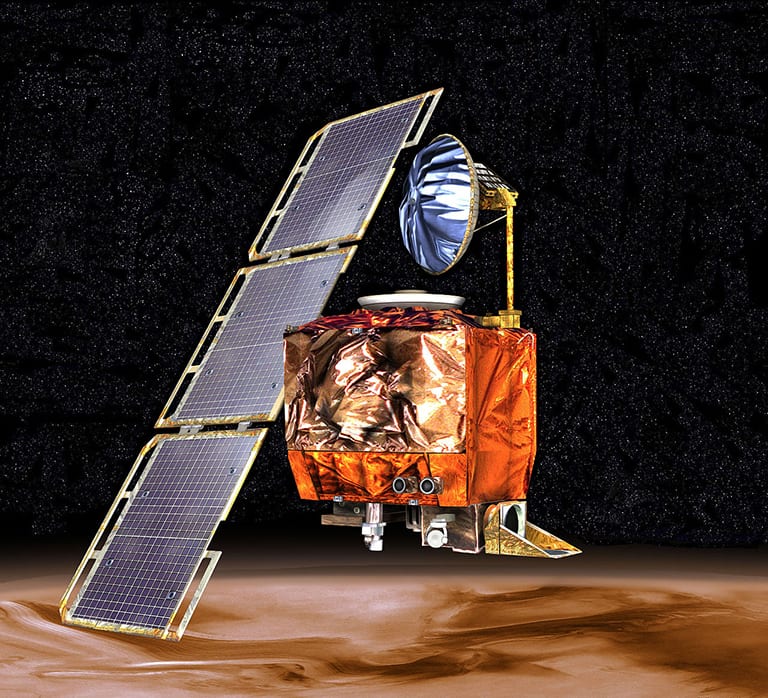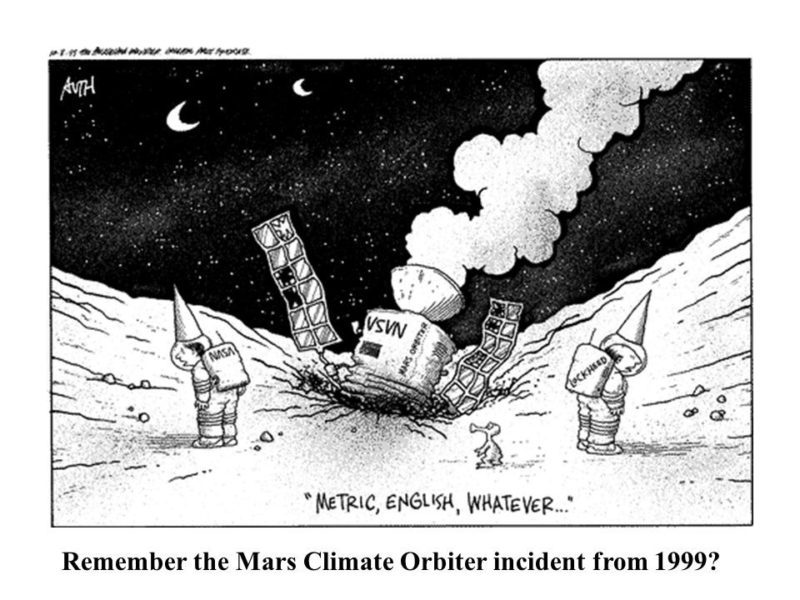In September of 1999, after almost 10 months of travel to Mars, the Mars Climate Orbiter burned and broke into pieces. On a day when NASA engineers were expecting to celebrate, the ground reality turned out to be completely different, all because someone failed to use the right units, i.e., the metric units! The Scientific American Space Lab made a brief but interesting video on this very topic.
NASA’s Lost Spacecraft The Metric System and NASA's Mars Climate Orbiter
The Mars Climate Orbiter, built at a cost of $125 million, was a 638-kilogram robotic space probe launched by NASA on December 11, 1998, to study the Martian climate, Martian atmosphere, and surface changes. In addition, its function was to act as the communications relay in the Mars Surveyor ’98 program for the Mars Polar Lander. The navigation team at the Jet Propulsion Laboratory (JPL) used the metric system of millimeters and meters in its calculations, while Lockheed Martin Astronautics in Denver, Colorado, which designed and built the spacecraft, provided crucial acceleration data in the English system of inches, feet, and pounds. JPL engineers did not take into consideration that the units had been converted, i.e., the acceleration readings measured in English units of pound-seconds^2 for a metric measure of force called newton-seconds^2. In a sense, the spacecraft was lost in translation.

Before venturing further into what happened on that dreaded day, let’s try to understand the different units of measurement and how they came into use in various regions across the globe. In the past, various regions of the world followed the measurement systems and units that were most convenient for them. For example, in one part of the world, the cycle of the sun was assumed to be a measure of time, whereas elsewhere, it was the lunar cycles that were used to define time. Additionally, the lack of communication tools prevented scholars from communicating, discussing, and comparing ideas with scholars across the globe. Thus, over the course of centuries, different units and measuring standards have evolved independently.
As the world has grown closer, the need for a single unified system of units has emerged. Credit to several developments in the metric system can be dated back to the French revolution when it was first envisioned. Subsequently, two platinum standards were created representing the meter and the kilogram in the Archives de la République in Paris. This can be considered the first step the development of the present International System of Units.
Following the French revolution, Johann Carl Fredrich Gauss, a German mathematician, strongly promoted the use of this metric system. Alongside meters and kilograms, he added the “seconds” defined in astronomy, as a coherent system of units for the physical sciences. James Clerk Maxwell and Sir Joseph John Thomson, through the British Association for the Advancement of Science (BAAS), carried forward Gauss’ initiative to formulate the requirement for a coherent system of units with base units and derived units. The CGS system, a three-dimensional coherent unit system based on the three units—centimeter, gram and second—using prefixes ranging from micro to mega to express decimal sub-multiples and multiples, emerged because of their efforts. In 1889, the first General Conference on Weights and Measures (CGPM) sanctioned the international prototypes for the meter and the kilogram. Together with the astronomical second as the unit of time, these units constituted a three-dimensional mechanical unit system, just like the CGS system, but with the base units as meter, kilogram and second.
It was Giovanni Giorgi, an Italian physicist and electrical engineer, who proved that it is possible to combine the mechanical units of this meter–kilogram–second system with the practical electric units to form a single coherent four-dimensional system by adding to the three base units, a fourth base unit of an electrical nature, such as the ampere or the ohm, and rewriting the equations occurring in electromagnetism in the so-called rationalized form. Following these developments, in 1939, the four-dimensional system based on the meter, kilogram, second and ampere was recommended to the Consultative Committee for Electricity and Magnetism (CCEM) and was approved by the International Committee for Weights and Measures (abbreviated CIPM from the French Comité international des poids et mesures) in 1946. Following suit, Ampere, Kelvin, and Candela were added as base units in 1954, and Mole was added as the 7th base unit in 1971. Today, there are seven base units: Meter (Distance), Kilogram (Weight), Seconds (Time), Ampere (Electric current), Kelvin (Temperature) and Candela (Luminosity).
USA & NASA SI in the United States
If one travels to the US, one will notice these changes immediately; there are miles instead of kilometers, pounds instead of kilograms, and so on. For almost 22 years of my life, I had used kilograms and when I went to live in the US, the “pound” was totally new to me. While I could predict how much I would get if I bought a kilogram of an item, I had no sense of what one pound meant. The US remains one of only seven countries where SI units are not adopted.
The American system of measuring distance in inches, feet, and yards is based upon the units from England, which is where the first settlers came to the US on the Mayflower. While much of the rest of the world uses the metric system of centimeters, meters, and kilometers, the US has continued to use the English units. One foot is the same as 12 inches, and a yard is 36 inches—and the confusion continues. In metric, 1 meter is 100 centimeters, and a kilometer is 1000 meters. However, it is undeniable today that a large number of multinationals and international businesses work with and/or in the United States. This makes it even more important to be able to use common units of measurement.
Comprehending the overwhelming advantages of the metric system, the US Congress adopted SI units as the preferred measurement system in 1975 through the “Metric Conversion Act” which was signed by US President Gerald Ford. However, the act also allowed the use of US customary units. Further on, in the 1980s, the federal government tried to introduce metric in the United States. Speedometers on the cars from that time showed both miles per hour and kilometers per hour. However, these attempts at changing to metric were not successful.
Even though the US Congress has adopted SI as the preferred measurement system for the United States, the vast majority of businesses continued to use US customary units. This reservation against metric, however, changed almost instantaneously, at least at the best space agency in the world in 1999. This change occurred after a disaster investigation board reported that NASA’s Mars Climate Orbiter burned up in the Martian atmosphere.
NASA’s Lost Spacecraft NASA's Mars Climate Orbiter Disaster

A NASA review board found that the problem was in the software controlling the orbiter’s thrusters. The software calculated the force that the thrusters needed to exert in pounds of force. A second piece of code that read this data assumed it was in the metric unit—“newtons per square meter”.
During the design phase, the propulsion engineers at Lockheed Martin in Colorado expressed force in pounds. However, it was standard practice to convert to metric units for space missions. Engineers at NASA’s Jet Propulsion Lab assumed the conversion had been made. This navigation mishap pushed the spacecraft dangerously close to the planet’s atmosphere where it presumably burned and broke into pieces, killing the mission on a day when engineers had expected to celebrate the craft’s entry into Mars’ orbit.
The contributing factors that led to the disaster, as reported by the Mars Climate Orbiter failure board, were eight-fold. According to NASA’s board, errors were undetected within ground-based computer models of how small thruster firings on the spacecraft were predicted and then carried out on the spacecraft during its interplanetary trip to Mars. Furthermore, the board added that the operational navigation team was not fully informed of the details of the way that Mars Climate Orbiter was pointed in space, as compared to the earlier Mars Global Surveyor mission.
The initial error was made by contractor Lockheed Martin Astronautics in Colorado, which, like the rest of the U.S. launch industry, used English measurements. The contractor, by agreement, was supposed to convert its measurements to metrics. The systems engineering function within the project, whose responsibility was to track and double-check all interconnected aspects of the mission, was not robust enough. The board added that this was exacerbated by the first-time handover of a Mars-bound spacecraft from a group that constructed it and launched it to a new, multi-mission operations team.

NASA's Miscalculations Other Instances of Conversion Errors
Gimli Glider
This was not the only disaster in history that was directly caused by conversion errors. 1983 is famous for the “Gimli Glider” incident, in which Air Canada’s Boeing 767 jet ran out of fuel mid-flight because of a mistake in figuring out the fuel supply of the airline’s first aircraft using metric measurements.
Canada was one of the countries that employed the imperial system until 1970 when the nation began to change over to metric. Metrication (as it was called) took some time—about fifteen years or more. One of the industries that were late to change over was the airline industry, which was mainly due to the expense and longevity of the equipment.
The pre-flight fueling protocol of the flight required to convert volume (liters) into mass (kilograms or pounds, depending on the system in use) to estimate the amount of fuel required. Instead of figuring out how many liters the plane needed to hit the required payload of 22,300 kg, the crew calculated how many liters were needed to hit 22,300 pounds. This was half the quantity of fuel required, which meant that the flight only had enough fuel to make it halfway to the destination. This turned out to be a major—and potentially life-threatening—problem as the vehicle in question was an airplane cruising at 12,500 meters above the ground.
Luckily for all on board, the pilot had ten years of glider training under his belt, and his co-pilot knew the surroundings quite well. The skilled pair was able to land the 767—gliding the last 100 kilometers, ensuring the safety of everyone on board.
Lesser Known Incidents
There have been several lesser-known occurrences of conversion mishaps. The Institute for Safe Medication Practices reported an instance where a patient had received 0.5 grams of Phenobarbital (a sedative) instead of 0.5 grains because the recommendation was misread. A grain is a unit of measure equal to about 0.065 grams. The Institute emphasized that only the metric system should be used for prescribing drugs.
In yet another event, an aircraft was more than 13,000 kilograms overweight. In 1994, the FAA received an anonymous tip that an American International Airways (now Kalitta Air, a cargo airline) flight had landed 15 tons heavier than it should have. The FAA investigated and discovered that the problem was in a kilogram-to-pounds conversion (or lack thereof).
Finally, it is worth mentioning that even Columbus had conversion problems. He miscalculated the circumference of the earth when he used Roman miles instead of nautical miles, which is part of the reason he unexpectedly ended up in the Bahamas on October 12, 1492, and assumed he had hit Asia.
NASA’s Lost Spacecraft Units in FEM
As one would have noticed, there are no predefined units when using FEM software. It is left to the user to ensure that the right conjugates are used. If the unit used for length is meter, then the right units for other aspects of mechanical units are kilograms and seconds. In contrast, if the units are millimeters, then the right units are milligrams and milliseconds, and so on. Every time you think about setting up your simulations, you have to give the units a thought!

Explore FEA in SimScale
When using an FEA or CFD simulation software, be aware that not all the solutions on the market offer both the metric and the imperial units. To help our users avoid making design mistakes, SimScale supports both the metric and the imperial systems, which you choose in the first step of creating your simulation. All you have to do is make sure your collaborators use the same system.
References
- Metric Math Mistake Muffed Mars Meteorology Mission by Wired
- Mars Climate Orbiter on Wikipedia
- NASAs metric confusion caused Mars orbiter loss by CNN
- Mars Probe Lost Due to Simple Math Error by LA Times
- The Math Mistake That Doomed a Mars Probe in 1999 in Popular Mechanics
- NASA criticized for sticking to Imperial units by New Scientist
- NASA reworks its sums after Mars Fiasco by Nature



